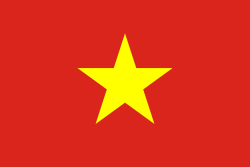

The following outline is provided as an overview of and topical guide to Vietnam:
Contents
- General reference
- Geography of Vietnam
- Environment of Vietnam
- Regions of Vietnam
- Demography of Vietnam
- Government and politics of Vietnam
- Branches of the government of Vietnam
- Foreign relations of Vietnam
- Law and order in Vietnam
- Military of Vietnam
- Local government in Vietnam
- History of Vietnam
- Culture of Vietnam
- Art in Vietnam
- Religion in Vietnam
- Sport in Vietnam
- Economy and infrastructure of Vietnam
- Education in Vietnam
- Health in Vietnam
- See also
- References
- External links
Vietnam – a sovereign country located on the eastern extent of the Indochinese Peninsula in Southeast Asia. [1] It is bordered by China to the north, Laos to the northwest, Cambodia to the southwest, and the South China Sea to the east. With a population of over 98 million, Vietnam is the 15th most populous country in the world.
Vietnam was under Chinese control for a thousand years before becoming a nation-state in the 10th century. Successive dynasties flourished along with geographic and political expansion deeper into Southeast Asia, until it was colonized by the French in the mid-19th century. Efforts to resist the French eventually led to their expulsion from the country in the mid-20th century, leaving a nation divided politically into two countries. Bitter fighting between the two sides continued during the Vietnam War, ending with a communist victory in 1975.
Emerging from a long and bitter war, the war-ravaged nation was politically isolated. The government's centrally planned economic decisions hindered post-war reconstruction and its treatment of the losing side engendered more resentment than reconciliation. In 1986, it instituted economic and political reforms and began a path towards international reintegration. By 2000, it had established diplomatic relations with most nations. Its economic growth had been among the highest in the world in the past decade. These efforts culminated in Vietnam joining the World Trade Organization in 2007 and its successful bid to become a non-permanent member of the United Nations Security Council in 2008.




